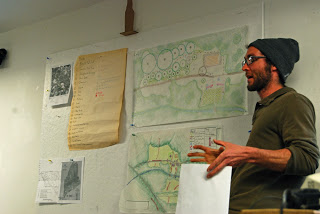The cornerstone of my Design/Build internship with Yestermorrow is choosing six weeks of courses from a rich and eclectic catalog, everything from building yurts to designing forest gardens. It was a real struggle for me to choose; I would literally take every offering—but I can’t.
Looking at the available courses, I eventually concluded that my “goal” was to become a better designer. Admittedly I didn’t know exactly what this meant. Drafting? Sketching? Organizing and utilizing space for efficiency? Aesthetics? Comfort? Admittedly I still don’t have a clear idea, but I’d guess that most designers spend a lifetime figuring it out.
Luckily I’ve fallen in love with the process of “figuring it out.” So far I’ve manipulated space and ideas, in diverse shades, intensities, and materials—from houses to paper to landscapes. I’ve found that it all comes back to choice—asking what to think about and how to think about it, playfully, with flexibility and confidence. A house can look like almost anything—a box, a passive solar rectangle, or, in Paul Hanke’s case, a dragon. Seeing there is no shortage of options, the heart of design lies in the process, because at the end of the day we have to make a choice—and then create something. Maybe design is exactly that: a process for distilling and focusing a world of possibilities into a single point, so that we can sit in a chair, have a roof over our heads, and interact with the world (and stop designing!).
The Permaculture Design Certification Course is providing me with an especially cogent ecological lens for informing this process. Simply put, we humans are merely features within a much broader environmental dance—with water, changes in terrain, soil, wildlife, celestial mechanics, and the many other feature of our ecology. Anything that we build will be subject to this context—a chair lives within a particular house, on a particular street, in a particular bioregion, not in a vacuum. Permaculture encourages us to deeply and carefully observe our environment so that we can design from it rather than against it. I’m already discovering that ecology can inform and direct design, rather than the other way around.
Speaking of which, I need to get back to designing maps, landscapes, and trees of colored pencil. I’ll design another blog entry soon.

